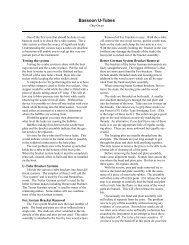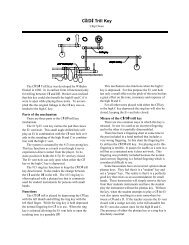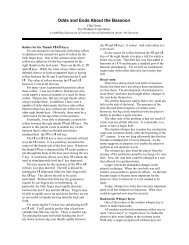English Horn playing guide pdf - Fox Products
English Horn playing guide pdf - Fox Products
English Horn playing guide pdf - Fox Products
You also want an ePaper? Increase the reach of your titles
YUMPU automatically turns print PDFs into web optimized ePapers that Google loves.
8<br />
ASSEMBLY AND CARE OF THE ENGLISH HORN<br />
The <strong>English</strong> horn is assembled in the same manner as the<br />
oboe. Of great importance in the process is the careful<br />
and proper alignment of the bridging keys between the<br />
upper and lower joints. The use of a bit of cork grease on<br />
the cork joints is good, since it does away with the tendency<br />
to “force” the fit of the joints. If the joint is unstable,<br />
there may be too much cork grease, which can be<br />
removed with a tissue.<br />
There are two bridging keys between the upper and lower<br />
joint. On one side is the trill key bridge for the C-D trill.<br />
On the other side is the bridge for the fingering combination<br />
for C and B♭. Assembly of the upper and lower joints<br />
is easily accomplished by observing from the back of the<br />
instrument, the better to see the alignment of the bridging<br />
keys. The bell joint presents no problem, since there is<br />
only one bridge.<br />
BELL<br />
The <strong>English</strong> horn also uses a bocal, which extends from the<br />
top of the instrument, curving toward the player. The reed<br />
tube slips over the top of the bocal, completing the<br />
assembly. Some players find it very useful to use a piece of<br />
thin rubber or plastic tubing as an airtight bond at the<br />
juncture of the reed tube and the bocal. A short piece of<br />
aquarium tubing works quite well. In addition to making a<br />
good seal, this prevents the reed from slipping off the<br />
bocal during performance.<br />
■ Always soak the reed while putting the <strong>English</strong> horn<br />
together. Dip the reed in water, shake off the excess<br />
water and let it stand for a few minutes before <strong>playing</strong><br />
on it. If left standing in water, the reed becomes quite<br />
open and difficult to manage. If water is not available,<br />
the reed can be moistened with saliva.<br />
LOWER JOINT








